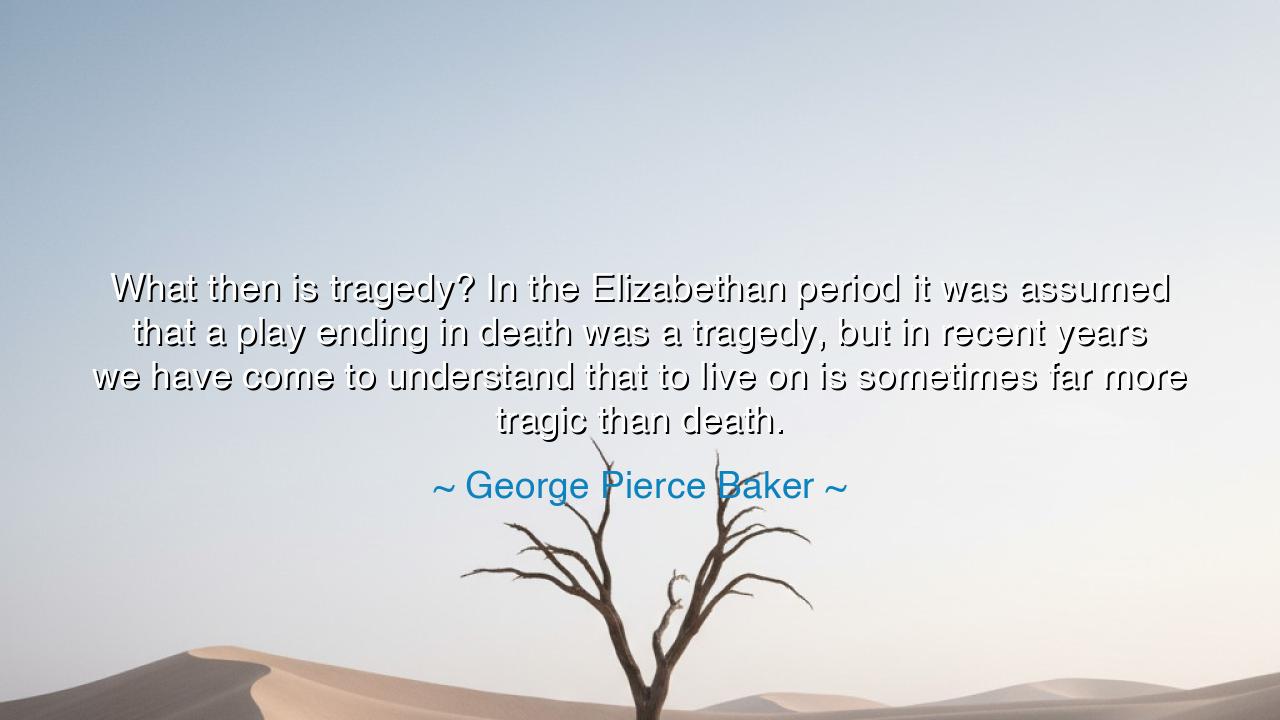
What then is tragedy? In the Elizabethan period it was assumed
What then is tragedy? In the Elizabethan period it was assumed that a play ending in death was a tragedy, but in recent years we have come to understand that to live on is sometimes far more tragic than death.






In the reflective and piercing words of George Pierce Baker, a master of literary understanding, we are brought to confront a truth both subtle and profound: “What then is tragedy? In the Elizabethan period it was assumed that a play ending in death was a tragedy, but in recent years we have come to understand that to live on is sometimes far more tragic than death.” Here lies a wisdom carved from the deepest chambers of the human heart—that suffering does not always end with death, and that there are fates worse than the grave. The ancient poets knew this truth in glimpses, but it is in the modern soul, stripped of divine certainties, that it finds its full, aching meaning.
George Pierce Baker, an American scholar of drama in the early twentieth century, lived at a time when the theater itself was evolving—from the grand spectacles of death and destiny that marked the age of Shakespeare, to a new realism that explored the quiet agony of survival. In the Elizabethan period, tragedy was bound to death, for death was the ultimate fall—the proof of human frailty before the gods or fate. In Hamlet, Othello, Macbeth, and King Lear, the body count marks the end of suffering. But Baker, watching the theater of his own age unfold, saw a new kind of tragedy arise—one where the hero does not die, but lives to bear the unbearable. In this lies the essence of modern sorrow: that to live on, broken yet breathing, is sometimes the heaviest punishment of all.
What, then, is tragedy in its truest form? It is not the sword’s fatal thrust, nor the poison’s final drop—it is the aftermath. It is the silence that follows the fall, the hollow days after loss, when the living must face what the dead escape. In the ancient world, the hero’s death was the culmination of his glory; it brought his story to a noble close. But in the modern heart, where faith in immortality has waned and meaning is fragile, tragedy dwells not in dying, but in enduring without purpose. To live when one’s dreams are shattered, when love is gone, when the world has turned cold—that is the living tragedy Baker speaks of.
Consider the fate of King Lear, the aged monarch who, after the storm and the madness, survives the ruin of his kingdom only to cradle the lifeless body of his daughter, Cordelia. His death is merciful—swift and final—but the true agony lies in those moments before it, when he lives to see the wreckage of his folly. Shakespeare himself, though an Elizabethan, glimpsed Baker’s later truth: that living on can wound more deeply than dying. For death closes the wound, but life forces one to carry it, raw and open, through every breath. This is the sorrow not of heroes, but of humans—those who wake each day and face the emptiness of what they have lost.
History, too, is filled with such tragedies of endurance. Think of h Frank, the mother of Anne Frank, who lived long enough in the concentration camp to see her husband and daughters taken from her, yet lingered before her own end, powerless to protect them. Or think of the survivors of war, who emerge from the ashes not as victors, but as witnesses to horrors that memory will not let them forget. Their suffering, though unseen, is more profound than any death on the battlefield. For they carry the burden of remembering—a torment that death would have relieved. Baker’s insight is not morbid; it is compassionate. It calls us to see the depth of human strength that endures, and the silent tragedy that endurance can contain.
Yet within this darkness, there is also light. For to live on in spite of tragedy is not merely to suffer—it is to persist, and persistence itself can become a kind of heroism. While death ends the tale, life allows the wounded soul to seek redemption, to find meaning even in pain. The modern hero, unlike his ancient counterpart, does not seek a glorious end; he seeks the courage to continue. And in that quiet perseverance lies a new kind of greatness. The tragedy of living on is not only a burden—it is a chance to transform suffering into wisdom, despair into depth, and grief into compassion.
So, my children of the present and the future, take this lesson to heart: do not fear death, but do not mistake mere survival for life. To live on after pain is to walk through fire, but it is also to prove the endurance of the human spirit. When the world wounds you, and it will, remember Baker’s truth: that the hardest path is not dying bravely, but living bravely after the fall. Use your grief as fuel for understanding, your loneliness as a bridge to others, your endurance as a quiet act of defiance against despair. For though to live on may at times feel tragic, it is also the noblest of all struggles—the triumph of the spirit that refuses to be extinguished, even in the face of ruin.
Thus, George Pierce Baker’s words remind us that tragedy is not merely the art of death, but the art of survival. To live, though broken, is to bear witness to life’s full measure—to pain, to resilience, to the unyielding will of the soul. And in that endurance, in that sacred act of continuing, the human story finds its deepest, most enduring beauty.






AAdministratorAdministrator
Welcome, honored guests. Please leave a comment, we will respond soon